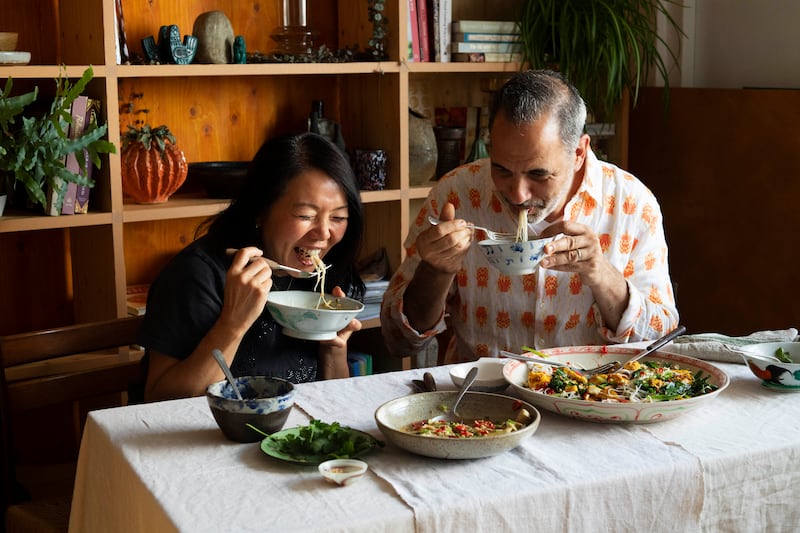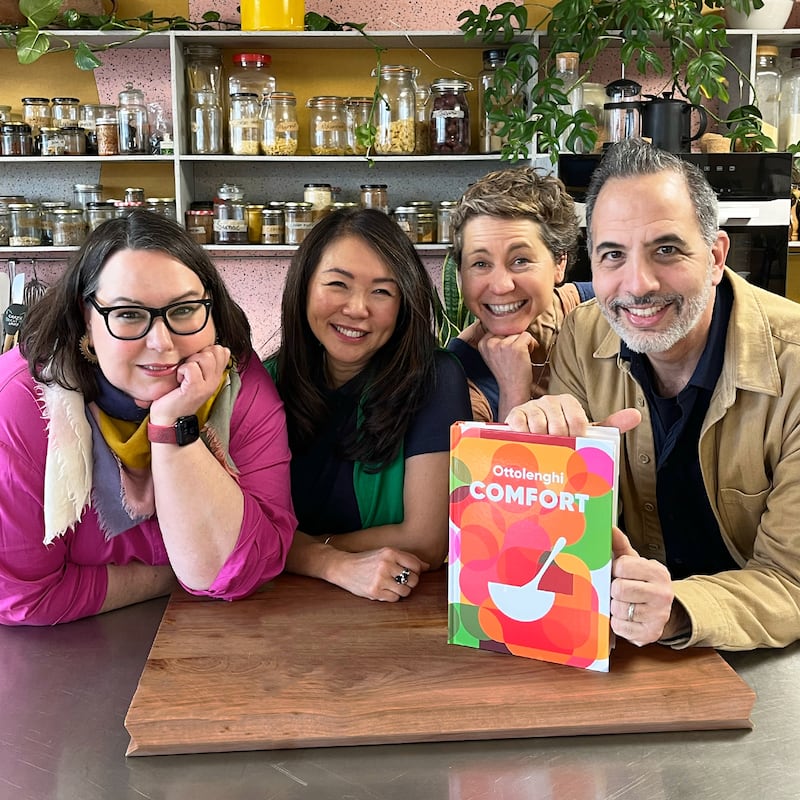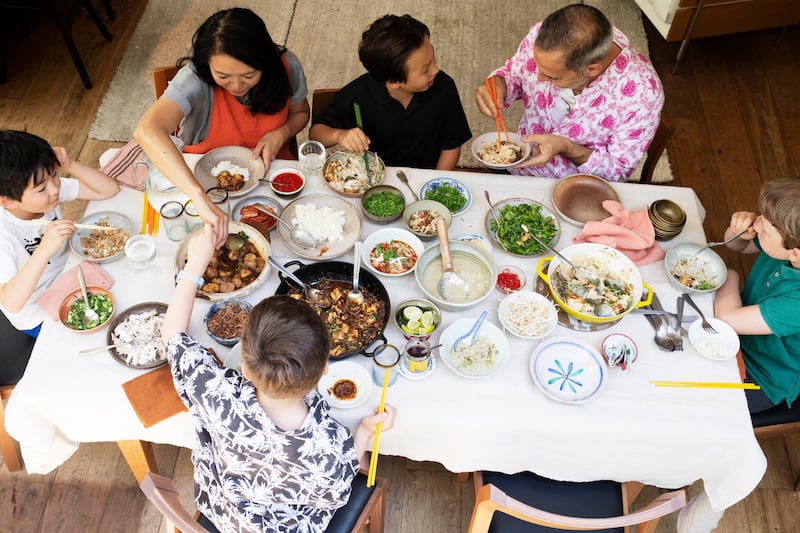“I think that food has been fetishised. Definitely,” says Yotam Ottolenghi. Our conversation has moved in a slightly different direction, considering the plan was to talk on Zoom about comfort food, but true to form, he offers an original viewpoint on the subject. There is never anything formulaic about Ottolenghi’s responses, no sense that he’s jaded with the interview circuit and endless questions about why his exhaustive ingredients lists read more like riddles.
“I think that food now happens on two almost completely parallel universes: the one where people cook and eat at home, and the one that people present on social media. And there’s hardly ever any overlap between the two any more, unfortunately. There’s people who have an idea of cooking and then people who have the reality of cooking. And I don’t think it’s a necessarily bad thing, because maybe things that happen on social media do eventually encourage people to get into the kitchen and cook. But the food porn doesn’t necessarily lead to food sex.”
Now there’s a good analogy, chimes in Helen Goh, who co-authored Ottolenghi’s newest cookery book, Ottolenghi Comfort, with him and two other food writers, Verena Lochmuller and Tara Wigley.

Ottolenghi describes Comfort as being a biographical and private book in many ways. There are no Instagram or TikTok moments. It is almost the opposite of restaurant food, he says. He has co-written cookery books with his chefs in the past, and always ensures that they get high-profile recognition for their contributions, but this book takes his food in a new direction.
It is about comfort food; not just the dishes themselves but how they connect to memories, family traditions and the experience of immigration. While Israel-born Ottolenghi brings the now-familiar flavours of the Levant, and Lockmuller brings influences from her time in Germany, Scotland and New York, it is Goh’s imprint that is most apparent. She was born in Malaysia, and her family emigrated to Australia when she was 10. She now lives in London and has been working in recipe development for Ottolenghi for 10 years.
“This is the first book that predominantly has a lot of Asian recipes that obviously come from Helen. It’s a very dominant part of the book,” says Ottolenghi. “And it was a real challenge, because I think historically, I have published recipes that have their origins in Asia, but they were always kind of the minority; a recipe here, a recipe there. This book has a big chunk which Helen created, or the majority, I would say. Helen brought so many flavours and ways of cooking and eating that I didn’t grow up in, and definitely Verena didn’t grow up with as well, and they have become so fundamentally enjoyable for us through this process of tasting and testing together.”
[ What Yotam Ottolenghi eats at home: ‘crispy pasta’Opens in new window ]
Considering the theme is comfort food, the challenge was to find the middle ground between what represented comfort food for Goh and what would resonate as comforting to the typical Ottolenghi reader, who he describes as predominantly western. Both found the recipe development process to be highly creative, always questioning if a recipe was too niche, or if the addition of a more unexpected ingredient might take it in an exciting new direction.
“We are constantly second-guessing how people react to recipes,” says Ottolenghi. “Of course, we know how people react because we have experience, but I can see something, and often I’d say to Helen, ‘but nobody will cook that’. You know, it’s just too much. It feels too far, and it feels too different. And it’s really fun to be able to take the core of something and translate it. So you need to kind of carry people with you sometimes. And then when you carry them along, I think you get them to come out of their comfort zone a bit.”
The result is a spectacular cookbook – no surprise, considering it’s from the Ottolenghi stable – but it does feel truly different. The opening chapter features “eggs, crêpes and pancakes”, with egg sambal shakshuka, aubergine omelette, steamed eggs with shrimps and chives, cheesy curry crêpes, polenta pancakes, and the Ottolenghi and Goh household favourite “the Dutch baby”, a puffed-up, baked egg delight that is like the love child of a pancake and a crêpe.

Another chapter is temptingly titled “Fritters and fried things”. You’ll find two very different recipes for hummus in “Soups, dips, spreads” (Ottolenghi says he loves Goh’s southern French version with fennel) and in the “Roast chicken and other traybakes” chapter you’ll find recipes for white poached chicken with Chinese cabbage and peanut rayu, shawarma meat loaf, and roasted hispi cabbage with miso butter. The “Dals, stews, curries” chapter delivers an equally tempting array of soy-braised pork belly, Japanese soul food, cumin and coriander flatbreads and chicken and lime leaf curry with noodles. If you’re thinking this sounds a bit different from the comfort food the typical Irish person grew up with, you’d be right. It is very much the point; we already have Darina and Delia for that.
More familiar recipes can be found in the “Pasta, polenta, potatoes” chapter, but, even for Ottolenghi, there are still recipes that are new to him. “Verena brought her German, northern European perspective. So there’s a great potato salad that she has introduced, which many people wouldn’t know. It’s a southern German version of our potato salad, where the unctuousness of the sauce comes out of stock and starch from the potatoes. And once the stock absorbs that starchiness with the warm potatoes, it turns into a self-saucing potato salad. It’s just so nice. You think you’ve seen it all, but actually she introduced me to this lovely potato salad that I know I’ve had before, but I didn’t know how it’s made. And so there’s a lot of those kind of eye-opening moments as well.”
I walk into a supermarket in the UK at this time of year, or even the autumn, and I see apples from New Zealand
— Ottolenghi on food's carbon footprint
This is Ottolenghi’s 10th cookery book, and the ingredients lists are considerably shorter than Jerusalem, when he and Sami Tamimi turned cooks everywhere into culinary scavengers, desperate to unearth Aleppo peppers, pomegranate molasses, Iranian dried limes and za’atar in speciality food shops. Part of the magic of his recipes is that they bring a little bit of the world to the table. But in an era where climate change is one of the big issues, is sustainability a consideration when developing new recipes?
“It comes into the conversation in restaurants. So where do we source? How do we source? How do we make sure that we don’t waste and how do we make sure that you have something that feels generous and interesting and dynamic, but still has all these environmental considerations discussed and acted upon?”
“When we do a book, I suppose I would say that what I’ve become better at it with the years. I do think that every ingredient needs to be justified, and we have long conversations in which we do have painstakingly difficult discussions about how we justify using three cheeses when one or two could be enough?” he says.
“And of course, it’s a tension that always exists in recipe writing and in food creation, you want it to be special. You want it to be different. You want people to have a sense of ‘oh, wow, I’ve never had that version of this thing before’. But you also don’t want them to hate you by asking you to use a third of a pack of a feta and then a third of a pack cream cheese and a third of a pack of cheddar, and then they’re left with that. So we’re having those conversations, and we always try to strike some kind of good balance, to encourage people to both buy the book and be surprised and enlightened by it, but also not feel they need to take an extra mortgage every time they cook a recipe from the book.”
[ How to liven up a chicken dinner: try this Yotam Ottolenghi-inspired dishOpens in new window ]
There is also the issue of obscure ingredients and, although you may need to stock your larder with a few additional southeast Asian ingredients, you’ll see plenty that are familiar, and none of the recipes have lengthy inventories. “I think in a way, it’s quite unfair that Yotam has the reputation for that because really, he is the one that tries to rein us in,” says Goh. “You know, does it really need that? He’s the one who’s really asking, how can we simplify?”
In terms of food miles, Ottolenghi says cumin and cardamom are not the big offenders because they have been traded for millenniums. “I think we should be looking at bottled water and things of that nature that really don’t need to be travelling,” he says. “There’s a whole bunch of ingredients that are unnecessary. Even just focusing on seasonality within the European context is enough for me to justify a lot of our decisions.
“So, you know, we use the beans in the summer, and berries in the spring and summer. I think that already cuts away quite a level within spices, and coffee; those are light ingredients that we’re not likely to be giving up any time soon, and it’s okay to transport them, because they make the tiniest impact compared to all the rest of the things that are being unnecessarily flown around the world.
“I walk into a supermarket in the UK at this time of year, or even the autumn, and I see apples from New Zealand, and I go like, how on earth can we have apples from New Zealand when there are so many apple trees everywhere?”

Ottolenghi and Goh each have two sons of similar ages, who are open to a wide variety of flavours. The four boys are already building foundations for interesting food careers, playing the role of tasters for some of the recipes. They will happily tuck into mushroom and kimchi mapo tofu, and Ottolenghi says that congee (Chinese rice porridge) is the first thing his two boys, Max and Flynn, order when they’re in a Chinese restaurant, even before dim sum, which is also a big hit.
As for their own food memories and what they will one day look back on as comfort food, the boys have also been introduced to traditional Irish food as Ottolenghi’s husband, Karl Allen, is from Co Down. At Christmas, the boys are on-hand to help Allen with the roast gammon, studding it with cloves after he’s coated it with brown sugar, and they’re very partial to a roast dinner. Quite predictably, they love sweets and desserts. There is, of course, a “sweet things” chapter.
“We spend quite a lot of time in Northern Ireland, because Karl is from there,” says Ottolenghi. “When we are there, we make soda bread, like the Northern Irish soda bread that you bake on the skillet.”
While the rest of us in the land of shepherd’s pie and lasagne may expect the Ottolenghi-Allen kids to be genetically wired to eat anything that’s put in front of them, it’s not always the case.
“I think it really has a lot to do with how vested they are in the process,” says Ottolenghi. “I think one of the things is, when you put something in front of them, out of nowhere that they haven’t had before, they have these notions of what they like and what they don’t like. But if they see it kind of unravelling or happening, they often get interested and are much more willing to try.”
“We went to this place in Enfield [Middlesex] recently where you pick your own fruit and veg. It was really nice,” he says. “Half a day we spent and they picked courgettes and beans and berries and sunflowers, and you come home with this bag full of stuff that they’ve picked themselves. I cooked the French beans with them in a way that is quite similar to the way we cook the French beans in the book here, so slow-cooked with the onion, garlic and olive oil and steaming themselves. And, you know, they’re not always that excited about French beans. Some things they do eat quite happily. But with that dish in particular, they just really wanted to eat it because we picked the beans ourselves. So, these are where the surprises normally come up.”
Having people over very casually is what’s happening now. And I know this sounds like I’ve rehearsed it, but I haven’t: I think that’s why a book like this is great
— Goh
And how are the boys when it comes to cooking? “They don’t really cook. I mean, the only time of the day that they do cook is breakfast. So they make eggs. They’re very proud of that. They make omelettes and scrambled eggs and things like that,” he says. “But other times of the day, no. Somehow, they show a lot of interest, but it only lasts for a little while. So you end up cooking yourself, really, at this point.”
Comfort has recipes that you may well cook during the week, but like with any Ottolenghi cookbook, it is likely that you will be earmarking many of them for relaxed, weekend cooking. My sense is that they would be particularly lovely for sharing with friends. I’m interested to know what the home entertaining scene is like in London. Is formal entertaining dead? Are people dining out with friends rather than at home? Or has everything dialled back a bit since the pandemic changed our eating habits?
“Having people over very casually is what’s happening now. And I know this sounds like I’ve rehearsed it, but I haven’t: I think that’s why a book like this is great,” says Goh. “Because it’s food you really want to eat. You’re not crafting it to be elegant. You’re not crafting it to be using the latest ingredient or to impress. You’re just making it because it tastes bloody good and your friends are around and you want to nourish them. The idea of a dinner party just feels exhausting. It feels like you’re trying to impress people, you’re trying to put something on. But the idea of being invited to someone’s kitchen for meatballs. I mean, who wouldn’t want that?”
“I’ve never been invited to so many dinner parties, but I do feel that there are fewer dinner parties than there used to be,” says Ottolenghi. “And I think it’s kind of tied into what Helen said about people wanting joy and comfort from food rather than something maybe a bit stilted and formal. One of the things that I realised, while talking about the book is that, I think 15 years ago, or even five years ago, the tendency was to go into the kitchen, for a lot of people, to challenge yourself – I’m going to learn something new. Now I think many people go into the kitchen for the opposite, to find comfort in cooking. And this is a trend that I’m sure is actually true, if someone would ever like to conduct some kind of survey about why people go into kitchens. I think that motivation to cook has really changed after Brexit, after Covid, after the financial crisis, and all the terrible wars that are happening In the world, that cooking has become something that helps to ground us, rather than to challenge us.”
Ottolenghi Comfort, by Yotam Ottolenghi, Helen Goh, Verena Lochmuller and Tara Wigley, is published by Ebury Press, €33.99

















